What is Noise in Communication?
Noise in communication systems is any unwanted signal that interrupts or distorts the flow of information during transmission, reception, or processing. It can distort, disrupt, or obscure the original message, leading to errors, misunderstandings, and loss of information.
Any unwanted signal causing interference to the required signal is called Noise. Noise voltage varies randomly with time, and its unpredictable nature prevents mathematical representation. So probability concepts are used to determine the noise power.
In noise calculations, AWGN (Additive White Gaussian Noise) is used. The effect of noise is additive and the most dominant noise is White Noise. The Gaussian density function is used to examine the noise.
Table of Contents
Types of Noise in Communication
1. Thermal Noise: Random fluctuations in electronic devices.
2. Interference Noise: Signals from other sources, such as radio waves or electrical currents.
3. Crosstalk Noise: Signals from adjacent communication channels.
4. Impulse Noise: Sudden, brief disturbances, like electrical spikes or clicks.
5. Quantization Noise: Errors introduced by digital signal processing.
A noise signal is made up of a variety of frequencies with unpredictable amplitudes. Noise may occur in a variety of ways. Data transmission signals are commonly disrupted by four main types of noise: man-made, thermal, correlated, and impulsive.
Man-made Noise
The noise produced by humans is referred to as man-made noise. The primary sources are devices that produce sparks, such as fluorescent lights, AC power-generating and switching equipment, automotive ignition systems, and commutators in electric motors.
It is made up of many frequencies that move across space similarly to radio waves and has an impulsive nature. Man-made noise, commonly known as industrial noise, is loudest in places with higher population densities.
Thermal Noise
The noise produced by the thermal agitation of electrons in a conductor is known as thermal noise. Because of its homogeneous distribution over the electromagnetic frequency range, it is also known as white noise. Noise power density, expressed as No = KT, is the thermal noise power contained in a 1-Hz bandwidth.
Since thermal noise is frequency independent, its presence in any bandwidth may be expressed as N = KTB, where T is the conductor temperature in kelvin (0K = -273oC), B is the bandwidth in hertz, K is the Boltzmann’s constant in joules per Kelvin, and N is the thermal noise power in watts. dBm is frequently used to quantify noise power.
Noise power in a resistor at room temperature, expressed in dBm, may be found using the following equation: NdBm = -174 dBm + 10 log B.
Correlated Noise
Correlated noise is the noise associated with signals; this noise can’t exist in a circuit without signals.
Nonlinear amplification results in associated noise, which comprises intermodulation and harmonic distortion. Also known as amplitude distortion, harmonic distortion happens when undesired harmonics of a signal are created by nonlinear amplification.
When two or more signals are amplified in a nonlinear device, undesirable sum and difference frequencies are created, known as intermodulation distortion.
Impulse Noise
Impulse noise is defined as short-duration, high-amplitude peaks throughout the noise spectrum. It consists of sudden, brief bursts of irregularly shaped pulses that vary in duration from a few microseconds to several milliseconds, depending on their amplitude and source.
Impulse noise may be quite bothersome in speech communications because it makes a harsh popping or cracking sound, but it can be disastrous in data circuits.
Noise Analysis of Modulation Techniques:
The performance of a modulation technique depends on the effect of noise. To determine the effects, the signal-to-noise ratio is calculated. However, the signal-to-noise ratio depends on the type of modulation technique.
Figure of Merit is used to compare various modulation techniques.
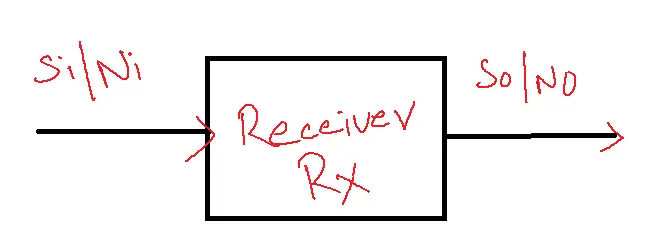
Figure of Merit= (So/No) / (Si/Ni)>>1
Noise Figure= (Si/Ni) / (So/No)<<1
White Noise:
We know that the thermal noise power P=KTB watts
KT=No=Power spectral density of thermal noise [W/Hz]
The Thermal Noise affects all frequencies equally.
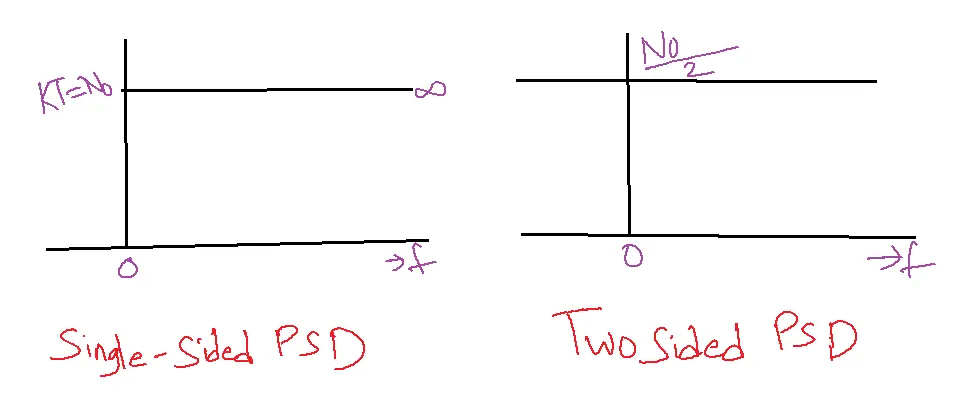
In noise calculations, two-sided PSDs are used.
The following formulas are used to calculate the noise power.
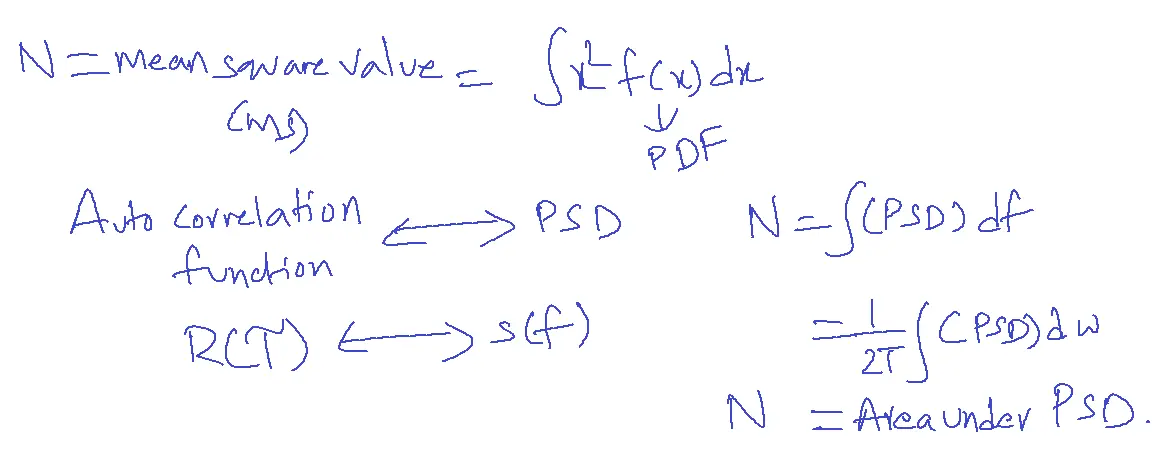
Transmission of a Random Signal/Noise through an LTI system:
Consider that the noise is filtered through an LTI system characterized by the transfer function h(f).
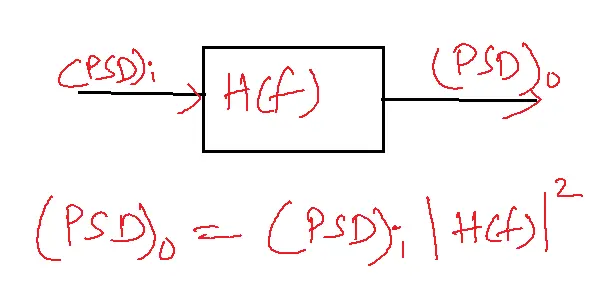
Transmission of White Noise through a Low Pass filter:
Consider a Low pass filter with a cutoff frequency of wHz.
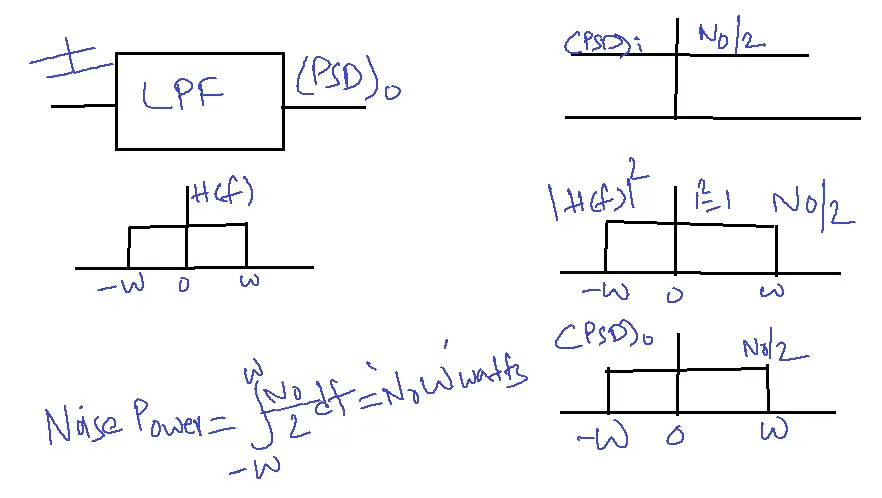
Transmission of Noise through a Band Pass filter:
Assume that white noise passes through a band pass filter. The range of frequencies selected by the filter depends on the modulation techniques. Assume that the modulation is amplitude modulation or DSB.
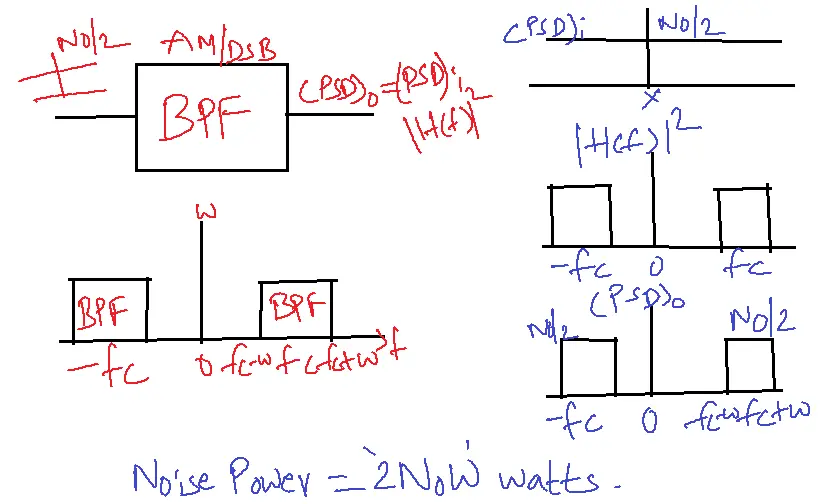
If the white noise is passed through the BPF the resultant noise at the output is called the Narrowband noise.
The narrow band noise is represented mathematically as
n(t)cos2πfct+nQ(t)sin2πfct
n(t) is inphase component
nQ(t) is Quadrature component.
Methods to Reduce Noise in Communication
1. Filtering: Removing unwanted frequencies.
2. Shielding: Protecting signals from external interference.
3. Error Correction: Detecting and correcting errors.
4. Signal Amplification: Boosting the original signal.
5. Noise Cancellation: Eliminating noise using specialized techniques.
Advantages of Noise in Communication
1. Error Detection: Noise can help detect transmission errors, allowing for correction and improvement of communication systems.
2. Security: Noise can used to mask sensitive information, making it difficult for unauthorized parties to intercept and understand the message.
3. Randomization: Noise can be used to randomize signals, making it harder for hackers to intercept and decode sensitive information.
4. Testing: Testing communication systems with noise can help uncover weaknesses and identify opportunities for improvement.
Disadvantages of Noise in Communication
1. Distortion: Noise can distort the original signal, leading to errors and misunderstandings.
2. Data Loss: Noise can cause information loss, resulting in missing or corrupted information.
3. Reduced Quality: Noise can degrade the quality of audio, video, or image signals.
4. System Failure: Excessive noise can cause complete system failure, disrupting communication.
Applications of Noise in Communication
1. Secure Communication: Noise is used in secure communication systems, such as encryption and coding.
2. Error Correction: Noise is used in error correction algorithms, such as checksums and digital signatures.
3. Random Number Generation: Random numbers, which are necessary for modeling, cryptography, and simulations, are produced by noise.
4. Communication Testing: Communication systems are tested with noise to make sure they are dependable and effective.
5. Audio and Image Processing: Noise is used in audio and image processing techniques, such as dithering and noise reduction.
Noise in Communication FAQs
1. What is Noise in Communication?
- Noise is any unwanted signal that interferes with the original transmitted signal in a communication system.
- It can corrupt or distort the information leading to reduced quality or complete message corruption.
2. What are the different types of Noise in Analog Communication?
- Thermal Noise: Also known as Johnson-Nyquist noise, it’s caused by the random motion of electrons in conductors and is present in all electronic systems.
- Shot Noise: Arises from the discrete nature of electron flow, often seen in semiconductor devices like diodes and transistors.
- Flicker Noise: Flicker noise, or 1/f noise, has a power spectral density inversely proportional to frequency, impacting low-frequency signals more prominently.
- Transit-Time Noise: Occurs in active devices at high frequencies due to the finite time taken by charge carriers to travel through the device.
- External Noise: Includes interference from man-made sources (industrial equipment, power lines) and natural phenomena (atmospheric noise, cosmic noise).
3. How does Noise affect Analog Communication?
- Reduced signal quality: Noise can reduce the signal-to-noise ratio (SNR), leading to decreased clarity and accuracy of the received signal.
- Limited transmission range: High noise levels limit the maximum distance a signal can be reliably transmitted.
- Increased error rates: In digital communication, noise can cause errors in the received data.
4. How can Noise be minimized in Analog Communication?
- Filtering: Using filters to remove unwanted frequency components.
- Shielding: Protecting the communication system from external electromagnetic interference.
- Amplification: Although amplification is necessary to enhance signal strength and combat noise, it inherently magnifies any noise in the signal.
- Modulation: Opt for modulation techniques like FM, which demonstrate superior noise performance compared to amplitude modulation (AM).
5. What is the Signal-to-Noise Ratio (SNR)?
- SNR is a measure of the desired signal’s strength compared to the noise level in the system. A higher SNR indicates a better-quality signal with less interference from noise. It’s usually expressed in decibels (dB).
